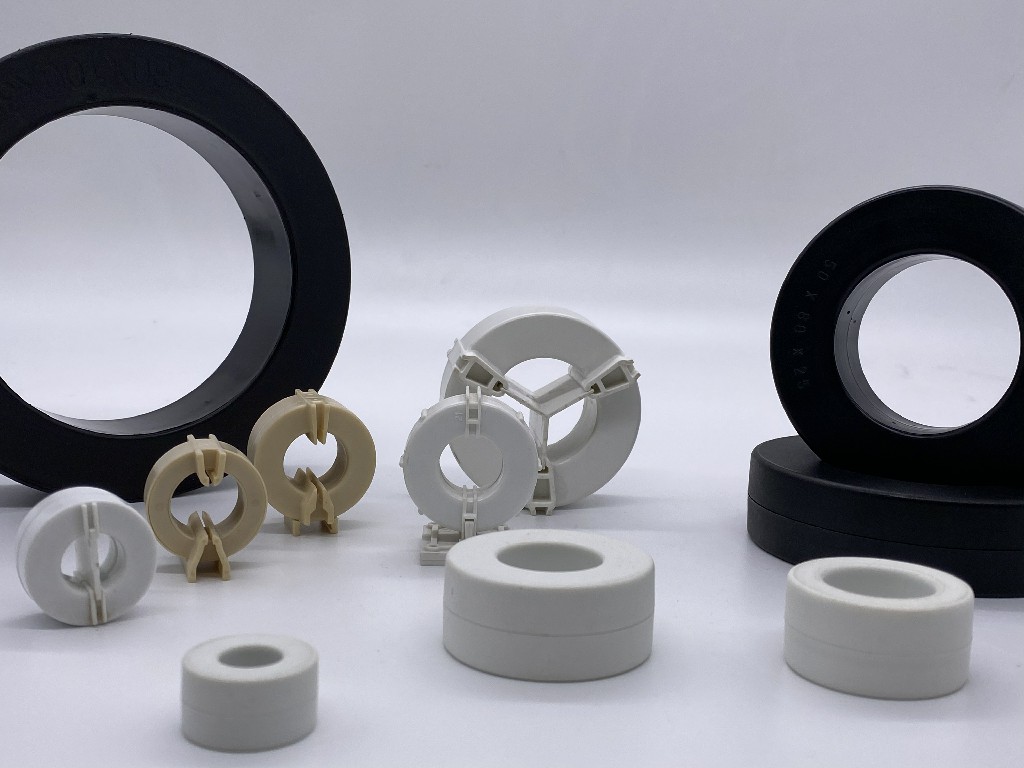Better Touch Better Business
Contact Sales at TRANSMART.
Amorphous alloys are solidified by super-rapid condensation. When the alloys are solidified, the atoms are too late to be ordered and crystallized. The resulting solid alloys have a long-range disordered structure without the crystal grains and grain boundaries of crystalline alloys. This amorphous alloy has many unique properties. Due to its excellent performance and simple process, it has become the focus of research and development in the material science community at home and abroad since the 1980s.The iron-based amorphous alloy is composed of 80% Fe and 20% Si, B type metal elements. It has high saturation magnetic induction intensity (1.54T), and its permeability, excitation current and iron loss are better than silicon steel sheets. specialty. In particular, the iron loss is low (1/3-1/5 of the oriented silicon steel sheet), and it can save energy by 60-70% instead of silicon steel as a distribution transformer. The thickness of the iron-based amorphous alloy strip is about 0.03mm, which is widely used in distribution transformers, high-power switching power supplies, pulse transformers, magnetic amplifiers, intermediate frequency transformers and inverter cores, suitable for use at frequencies below 10kHz.
Due to the super-rapid solidification, the atoms cannot be ordered and crystallized when the alloy is solidified. The resulting solid alloy has a long-range disordered structure without the crystal grains and grain boundaries of the crystalline alloy. It is called an amorphous alloy and is called a metallurgical material. A revolution in learning. This amorphous alloy has many unique properties, such as excellent magnetic properties, corrosion resistance, wear resistance, high strength, hardness and toughness, high electrical resistivity and electromechanical coupling properties.Because of its excellent performance and simple process, it has become the focus of research and development in materials science at home and abroad since the 1980s. In the past thousands of years, the metals or alloys used by human beings are all materials with crystalline structure, and their atoms are arranged in an orderly manner in the three-dimensional space to form a periodic lattice structure. Amorphous metal or alloy means that when the substance is rapidly cooled from the liquid (or gaseous) state, it is too late to crystallize and retain the disordered arrangement of the liquid atoms at room temperature or low temperature. The atoms no longer grow in order, periodicity and Regular arrangement, but out of a long-range disorderly arrangement state. Amorphous gold alloy with ferromagnetism is also called ferromagnetic metallic glass or magnetic glass (Glassy Alloy). For the convenience of description, all are referred to as amorphous alloy below.

In 1960, Professor Duwez in the United States invented the use of rapid quenching to prepare amorphous alloys. In the meantime, the development of amorphous soft magnetic alloys has generally gone through two stages: a stage from 1967 to 1988. In 1984, four transformer manufacturers in the United States demonstrated practical amorphous distribution transformers at the IEEE meeting, which marked the climax of the first stage. By 1989, AlliedSignal of the United States had an annual production capacity of 60,000 tons of amorphous strips. About 1 million amorphous distribution transformers have been put into operation, and almost all of the iron-based amorphous strips used are from the company.
Since 1988, the development of amorphous materials has entered the second stage. The landmark event at this stage is the invention of iron-based nanocrystalline alloys. In 1988, Yashiwa and others of Hitachi Metals, Japan developed a nanocrystalline soft magnetic alloy (Finemet) based on amorphous alloys through crystallization. In 1988, Hitachi Metals' nanocrystalline alloys were industrialized, and products were introduced to the market. In 1992, the German VAC company began to introduce nanocrystalline alloys to replace cobalt-based amorphous alloys. Especially in network interface equipment, such as ISDN, a large number of nanocrystalline magnetic cores are used to make interface transformers and digital filter components.
After having a preliminary understanding of amorphous alloys, we are looking at a very promising application field of amorphous alloys-amorphous transformers. Amorphous alloy iron core transformer is a transformer made of a new type of magnetic material-amorphous alloy to make the iron core. It is compared with silicon steel sheet as the no-load loss of the iron core transformer (refers to the transformer secondary open circuit, measured at the primary The power loss is reduced by about 75%, and the no-load current (when the secondary of the transformer is open, the primary still has a certain current, this part of the current is called the no-load current) is reduced by about 80%. It is currently a distribution transformer with ideal energy-saving effect. It is especially suitable for places with low load rates such as rural power grids and developing regions.
Beginning in 2006, the substantial price increase of silicon steel resulted in the price of amorphous steel being even lower than that of silicon steel; at the same time, its energy-saving effect has also attracted attention due to the emphasis on energy issues. Because of its lower loss rate, amorphous strip can play a very good role in reducing power consumption when used in new distribution transformers. As the Chinese transformer market accelerates the development of amorphous distribution transformers, amorphous strips The market for materials is constantly expanding. It is different from the traditional silicon steel sheet in that the amorphous alloy is fragile after punching, and it is difficult to form a laminate. Therefore, in practical applications, amorphous alloys often exist in the form of winding processes. In recent years, more and more motors use amorphous soft magnetic materials, and their low iron loss and excellent energy-saving properties have attracted extensive attention from the academic community.
Copyright © 2025 TRANSMART INDUSTRIAL LIMITED | All Rights Reserved
Hello, please leave your name and email here before chat online so that we won't miss your message and contact you smoothly.